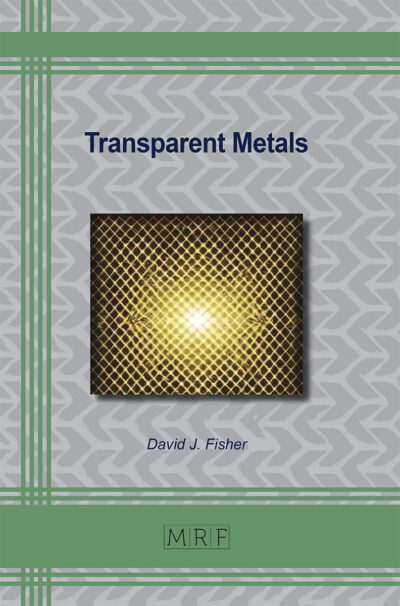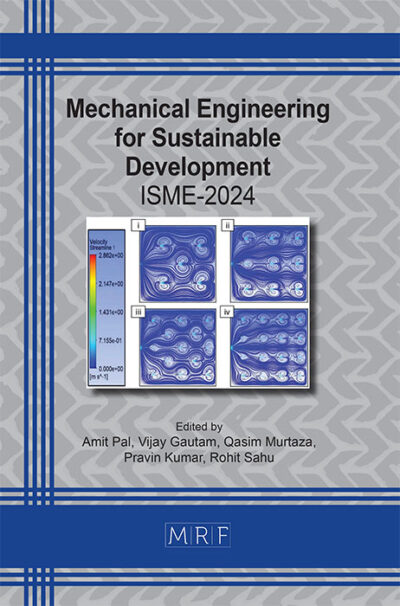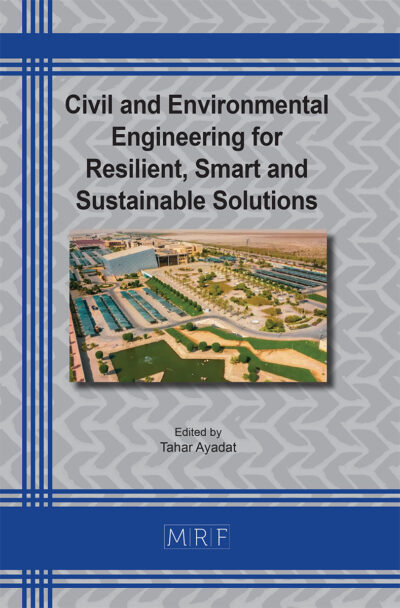Incorporating date seed powder (DSP) into asphalt binder: A feasibility study on sustainable and economical practices in Saudi Arabia
Rana Aldawood, Dalya Alshali, Zainab Almshar, Maryam Alkhuraim, Fawzyah Alkhammas, Mohammad Ali Khasawneh
Abstract. This research investigates the potential use of Date Seed Powder (DSP) as a sustainable modifier for asphalt binders in Saudi Arabia. Date seeds, a readily available byproduct of the date fruit industry, offer a promising alternative to traditional asphalt modifiers, promoting a circular economy and reducing reliance on non-renewable resources. The study proposes incorporating DSP into asphalt binders to enhance their performance and durability, particularly under extreme climatic conditions and heavy traffic loads. The research explores the advantages of using DSP, including its unique chemical composition, cost-effectiveness, and environmental benefits. The study outlines methods for collecting and preparing DSP, and discusses the environmental impact of date seed disposal. It also highlights the sustainability aspects and contribution of this approach to Saudi Arabia’s Vision 2030. The research concludes that using DSP as a binder modifier offers a promising solution for improving the durability and lifespan of roads in Saudi Arabia, contributing to a more sustainable and cost-effective infrastructure.
Keywords
Date Seeds Powder, Asphalt Binder, Sustainable Material, Transportation Infrastructure
Published online 2/25/2025, 11 pages
Copyright © 2025 by the author(s)
Published under license by Materials Research Forum LLC., Millersville PA, USA
Citation: Rana Aldawood, Dalya Alshali, Zainab Almshar, Maryam Alkhuraim, Fawzyah Alkhammas, Mohammad Ali Khasawneh, Incorporating date seed powder (DSP) into asphalt binder: A feasibility study on sustainable and economical practices in Saudi Arabia, Materials Research Proceedings, Vol. 48, pp 1050-1060, 2025
DOI: https://doi.org/10.21741/9781644903414-113
The article was published as article 113 of the book Civil and Environmental Engineering for Resilient, Smart and Sustainable Solutions
![]() Content from this work may be used under the terms of the Creative Commons Attribution 3.0 license. Any further distribution of this work must maintain attribution to the author(s) and the title of the work, journal citation and DOI.
Content from this work may be used under the terms of the Creative Commons Attribution 3.0 license. Any further distribution of this work must maintain attribution to the author(s) and the title of the work, journal citation and DOI.
References
[1] Yildirim, Y. (2007). Polymer modified asphalt binders. Construction and Building Materials, 21(1), 66-72. https://doi.org/10.1016/j.conbuildmat.2005.07.007
[2] Shen, J., Amirkhanian, S., Xiao, F., & Tang, B. (2009). Influence of surface area and size of crumb rubber on high temperature properties of crumb rubber modified binders. Construction and Building Materials, 23(1), 304-310. https://doi.org/10.1016/j.conbuildmat.2007.12.005
[3] Fini, E. H., Hajikarimi, P., Rahi, M., & Moghadas Nejad, F. (2016). Physicochemical, rheological, and oxidative aging characteristics of biomodified asphalt binder. Journal of Materials in Civil Engineering, 28(7), 04016031. https://doi.org/10.1061/(ASCE)MT.1943-5533.0001423
[4] M. Khasawneh, M. Taamneh, A.A. Al-Omari, T. Harahsheh, and A. Al-Hosainat, Experimental and statistical evaluation of asphalt binders produced in Jordan treated with different modi- fiers, J. Mater. Civ. Eng., vol. 32, no. 2, 2020. https://doi.org/10.1061/(ASCE)MT.1943-5533.0003003
[5] M.I. Bani Baker, R.M. Abendeh, and M.A. Khasawneh, Freeze and thaw effect on asphalt concrete mixtures modified with natural bentonite clay, Coatings., vol. 12, no. 11, pp. 1664, 2022. DOI: 10.3390/coatings12111664. https://doi.org/10.3390/coatings12111664
[6] M.A. Khasawneh, D.M. Al-Oqaily, A.H. Abu Alia, and A.A. Al- Omari, Evaluation of aggregate-binder bond strength using the BBS device for different road materials and conditions, Int. J. Pavement Eng., vol. 23, no. 9, pp. 2889-2902, 2022. https://doi.org/10.1080/10298436.2021.1873332
[7] M.A. Khasawneh, and S.K. Alyaseen, Analytic methods to evaluate bituminous mixtures enhanced with coir/coconut fiber for highway materials, Mater. Today: Proc., vol. 33, pp. 1752- 1757, 2020. DOI: 10.1016/j.matpr.2020.04.870. https://doi.org/10.1016/j.matpr.2020.04.870
[8] K. Andrews, S. Dernayka, M.A. Mir, and M.A. Khasawneh, Review of the utilization of plastic waste in asphalt pavements in hot climate conditions-KSA as a case study, Mater. Today: proc., 2023. https://doi.org/10.1016/j.matpr.2023.05.463
[9] M.A. Khasawneh, K. Ghuzlan, and N. Bani Melhem, Evaluation of Carbon nanotubes asphalt modification using the superpave criteria, KEM., vol. 902, pp. 135-143, 2021. https://doi.org/10.4028/www.scientific.net/KEM.902.135
[10] M.A. Khasawneh, A.A. Al-Omari, M.M. Taamneh, and D.F. Al-Theeb, Rutting and resilient modulus behavior of asphalt concrete modified with crump tire rubber, microcrystalline synthetic wax and nano silica, Int. Rev. Civ. Eng., vol. 12, no. 3, 2021. https://doi.org/10.15866/irece.v12i3.19609
[11] M.A. Khasawneh, M.T. Al-Jarrah, and B.A.M. Al-Malak, Assessing the use of alumina microfibers as modifiers to enhance the physical and rheological properties of asphalt binders, Int. J. Pavement Res. Technol., vol. 15, no. 2, pp. 284-302, 2022. https://doi.org/10.1007/s42947-021-00008-2
[12] A.A. Al-Omari, M.A. Khasawneh, T.M. Al-Rousan, and S.F. Al-Theeb, Static creep of modified superpave asphalt concrete mixtures using crumb tire rubber, microcrystalline synthetic wax, and nano-silica, Int. J. Pavement Eng., vol. 22, no. 6, pp. 794-805, 2021. https://doi.org/10.1080/10298436.2019.1646913
[13] M.A. Khasawneh, M.M. Taamneh, and O. Albatayneh, Evaluation of static creep of FORTA-FI strengthened asphalt mixtures using experimental, statistical and feed-forward back- propagation ANN techniques, Int. J. Pavement Res. Technol., vol. 12, no. 1, pp. 43-53, 2019. https://doi.org/10.1007/s42947-019-0006-3
[14] A.A. Al-Omari, T.S. Khedaywi, and M.A. Khasawneh, Laboratory characterization of asphalt binders modified with waste vegetable oil using SuperPave specifications, Int. J. Pavement Res. Technol., vol. 11, no. 1, pp. 68-76, 2018. DOI: 10.1016/j.ijprt.2017.09.004. https://doi.org/10.1016/j.ijprt.2017.09.004
[15] AlKheder, S., Alkhedher, M., & Alshraiedeh, K. A. (2021). The effect of using activated dates seed on Hot Mix Asphalt performance. Construction and Building Materials, 269, 121239. https://doi.org/10.1016/j.conbuildmat.2020.121239
[16] Foroutan Mirhosseini, A., Kavussi, A., Jalal Kamali, M. H., Khabiri, M. M., & Hassani, A. (2017). Evaluating fatigue behavior of asphalt binders and mixes containing Date Seed Ash. Journal of Civil Engineering and Management, 23(8), 1164-1175. https://doi.org/10.3846/13923730.2017.1396560
[17] Alattieh, S. A., Al-Khateeb, G. G., Zeiada, W., & Shanableh, A. (2020). Performance assessment of bio-modified asphalt binder using extracted bio oil from date seeds waste. International Journal of System Assurance Engineering and Management, 11, 1260-1270. https://doi.org/10.1007/s13198-020-00980-1
[18] Sukkari, A., Al-Khateeb, G., Zeiada, W., & Ezzat, H. (2022, February). Investigating the Physical and Rheological Properties of Date Seed Ash-Modified Asphalt Binders in the UAE. In 2022 Advances in Science and Engineering Technology International Conferences (ASET) (pp. 1-6). IEEE. https://doi.org/10.1109/ASET53988.2022.9735121
[19] Oladzad, S., Fallah, N., Mahboubi, A., Afsham, N., & Taherzadeh, M. J. (2021). Date fruit processing waste and approaches to its valorization: A review. Bioresource Technology, 340, 125625. https://doi.org/10.1016/j.biortech.2021.125625
[20] El-Habba, M. S., & Al-Mulhim, F. (2013). The competitiveness of the Saudi Arabian date palm: An analytical study. Afr. J. Agric. Res, 8(43), 5260-5267.
[21] Wallerstein, N., Duran, B., Oetzel, J. G., & Minkler, M. (2017). Community-Based Participatory Research for Health: Advancing Social and Health Equity. John Wiley & Sons.
[22] Smith, B., & Chinnappa, C. (2015). Plant Collection, Identification, and Herbarium Procedures. In E. Chee Tak Yeung, C. Stasolla, M. Sumner, & B. Quan Huang (Eds.), Plant Microtechniques and Protocols (pp. 541-572). Springer, Cham. https://doi.org/10.1007/978-3-319-19944-3_30
[23] Leal Filho, W., Ribeiro, P.C.C., Setti, A.F.F., Azam, F.M.S., Abubakar, I.R., Castillo‐Apraiz, J., Tamayo, U., Özuyar, P.G., Frizzo, K., & Borsari, B. (2024). Toward food waste reduction at universities. Environment, Development and Sustainability, 26(4), 16585-16606. https://doi.org/10.1007/s10668-023-03300-2
[24] Al-Khayri, J. M., Jain, S. M., & Johnson, D. V. (2015). The Role of Genetic Diversity in the Sustainability of Date Palm (Phoenix dactylifera L.) Agriculture. Journal of Plant Biology & Crop Research, 8(4), 1-15.
[25] Rahman, H., Vikram, P., Hammami, Z., & Singh, R. K. (2022). Recent advances in date palm genomics: A comprehensive review. Frontiers in Genetics, 13, 959266. https://doi.org/10.3389/fgene.2022.959266
[26] Al-Khayri, J. M., Jain, S. M., & Johnson, D. V. (2017). Date Palm Biotechnology Protocols Volume II: Germplasm Conservation and Molecular Breeding. https://doi.org/10.1007/978-1-4939-7159-6
[27] Zhang, R., Wang, H., Gao, J., Yang, X., & You, Z. (2017). Comprehensive performance evaluation and cost analysis of SBS-modified bioasphalt binders and mixtures. Journal of Materials in Civil Engineering, 29(12), 04017232. https://doi.org/10.1061/(ASCE)MT.1943-5533.0002098
[28] Jain, S., Chandrappa, A. K., & Neelancherry, R. (2024). Utilization of Agricultural Wastes and By-Products in Asphalt: A Critical Review. Agricultural Waste to Value-Added Products: Bioproducts and its Applications, 207-227. https://doi.org/10.1007/978-981-97-2535-9_10












